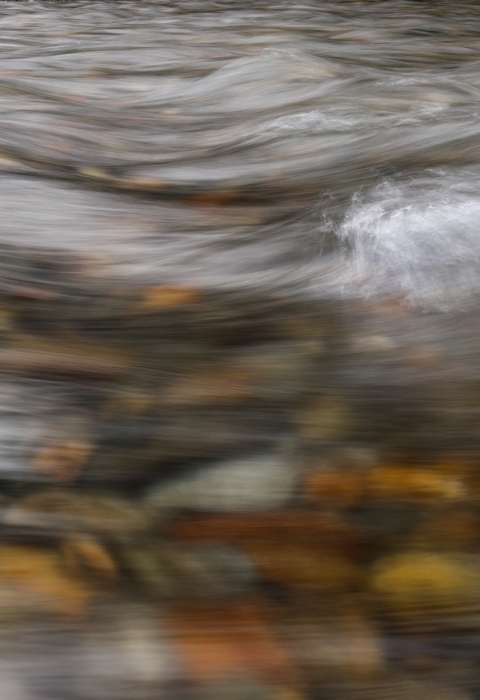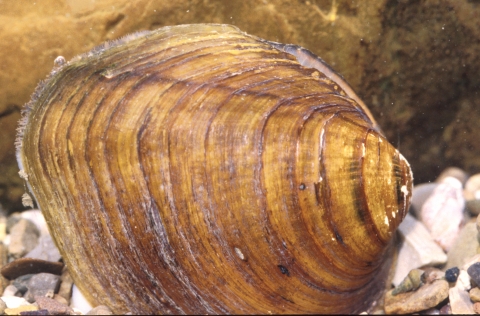What action is the U.S. Fish and Wildlife Service taking?
The Service is listing the longsolid and round hickorynut mussels as threatened under the Endangered Species Act and designating critical habitat for these two mussels.
What is the longsolid?
In 1831, Isaac Lea described the longsolid (Fusconaia subrotunda), as a medium-sized mussel up to 5 inches long that can live up to 50 years. It is found in small streams to large rivers, including the Ohio River, and prefers a mixture of sand, gravel, and cobble stream bottoms. It is found in nine states (Alabama, Indiana - inasmuch as it is found in the Ohio River, Kentucky, New York, North Carolina, Ohio, Pennsylvania, Tennessee, Virginia, and West Virginia). It has disappeared from Georgia, and Illinois. From a historical high of 160 known populations, only 60 are known to exist today, and 48 of those are small populations in poor condition.
What is the round hickorynut?
The round hickorynut (Obovaria subrotunda) is a small- to medium-sized mussel up to 3 inches long, which lives up to 15 years. It is found in small streams to large rivers, and prefers a mixture of sand, gravel, and cobble stream bottoms. The round hickorynut is found in nine states (Alabama, Indiana, Kentucky, Michigan, Mississippi, Ohio, Pennsylvania, Tennessee, and West Virginia). It has disappeared from Georgia, Illinois, and New York. From a historical high of 297 known populations, 69 are currently known to exist today, and 49 of those are in poor condition.
What threats brought the longsolid and round hickorynut to this point?
These mussels have suffered impacts from the negative effects of threats commonly associated with central and eastern U.S. streams, including habitat degradation or loss, genetic isolation, and invasive species invasive species
An invasive species is any plant or animal that has spread or been introduced into a new area where they are, or could, cause harm to the environment, economy, or human, animal, or plant health. Their unwelcome presence can destroy ecosystems and cost millions of dollars.
Learn more about invasive species .
What protections would these mussels receive by being on the threatened and endangered species list?
Federally funded or authorized projects would be reviewed for impacts on the listed mussels, and actions of the federal government may not jeopardize their existence. Listing would prohibit harassing, harming, pursuing, hunting, shooting, wounding, killing, trapping, or capturing the listed mussels and attempts to engage in such activity, except where permitted or in certain cases where it is part of a broader effort to conserve the mussels. The listing would make recovery efforts for the mussels eligible for funding under the ESA.
Is the Service finalizing a 4(d) rule as the ESA allows?
Yes. While endangered species are afforded blanket protections, section 4(d) of the ESA allows the Service to issue 4(d) rules that tailor protections for threatened species to better address their specific situation. According to these rules, certain actions with a minimal level of disturbance and no anticipated long-term negative impacts on the species would be exempted from ESA prohibitions. Those actions include conservation and restoration efforts by state wildlife agencies, stream bank and channel restoration projects, and forest management activities implementing state-approved best management practices which help protect stream quality.
What is critical habitat?
When the Service proposes an animal or plant for listing as endangered or threatened under the ESA, we identify specific geographic areas called critical habitat that is essential to conserving those species. The Service determines critical habitat based on what an animal or plant needs to survive and reproduce by reviewing the best scientific information concerning a species’ present and historical ranges, habitat, and biology.
Along with listing the longsolid and round hickorynut, the Service also designates critical habitat, or habitat critical to the recovery of the species. Designation of critical habitat does not affect land ownership, does not allow the government to take or manage private property, nor does it establish a refuge, reserve, preserve, or another conservation area conservation area
A conservation area is a type of national wildlife refuge that consists primarily or entirely of conservation easements on private lands. These conservation easements support private landowner efforts to protect important habitat for fish and wildlife and major migration corridors while helping to keep agricultural lands in production.
Learn more about conservation area , and it does not allow government or public access to private land.
Designating critical habitat on private land has no impact on landowner activities that do not require federal funding or federal permits. Critical habitat alerts federal agencies that they are required to make special conservation efforts when they work, fund, or permit activities, including consulting with the Service on the effects of their actions.
How much critical habitat is being designated for the longsolid and round hickorynut?
The critical habitat for the longsolid is comprised of 12 units, along a total of 1,115 river miles, in Alabama, Kentucky, Pennsylvania, Tennessee, Virginia, and West Virginia. Critical habitat for round hickorynut is comprised of 14 units along a total of 921 river miles in Alabama, Indiana, Kentucky, Mississippi, Ohio, Pennsylvania, Tennessee, and West Virginia. All units are occupied by the species, and all are considered essential to the conservation of the longsolid or round hickorynut mussels because they provide the suitable habitat necessary for this species to survive and reproduce. Eleven of the units are home to either existing critical habitat and/or habitat for threatened or endangered species.
How did the Service come to this conclusion?
The Service compiled and analyzed data for these wide-ranging species. The Service reached out to species and habitat experts, including staff in its own field offices, state wildlife agencies for each of the states where the mussels occur, and university and agency researchers and staff who work with these species to compile a range-wide status of the species and project its status into the future. These status assessments subsequently went through a peer-review process. For each of these species, this represents the first time such a comprehensive, range-wide investigation into their status has been conducted.
After examining historical, current, and projected future populations in light of the threats facing these mussels, the Service found that the longsolid and round hickorynut warrants the protection of the ESA, something afforded our most imperiled species.
Why should we care about mussels?
Although people are far more familiar with saltwater mussels commonly offered in restaurants, the United States is home to a tremendous diversity of freshwater mussels. There are more than 900 species worldwide, with North America being a global center of mussel diversity, with about 300 species. Despite the high amount of diversity, 65% of North American freshwater mussel species are imperiled. Sensitive to pollution, native mussels are indicators of broader stream health – vibrant mussel populations typically reflect a healthy stream. In addition to being indicators of stream health, mussels clean the water as they feed, filtering their food from the water, and with it, sediment and other pollutants.




